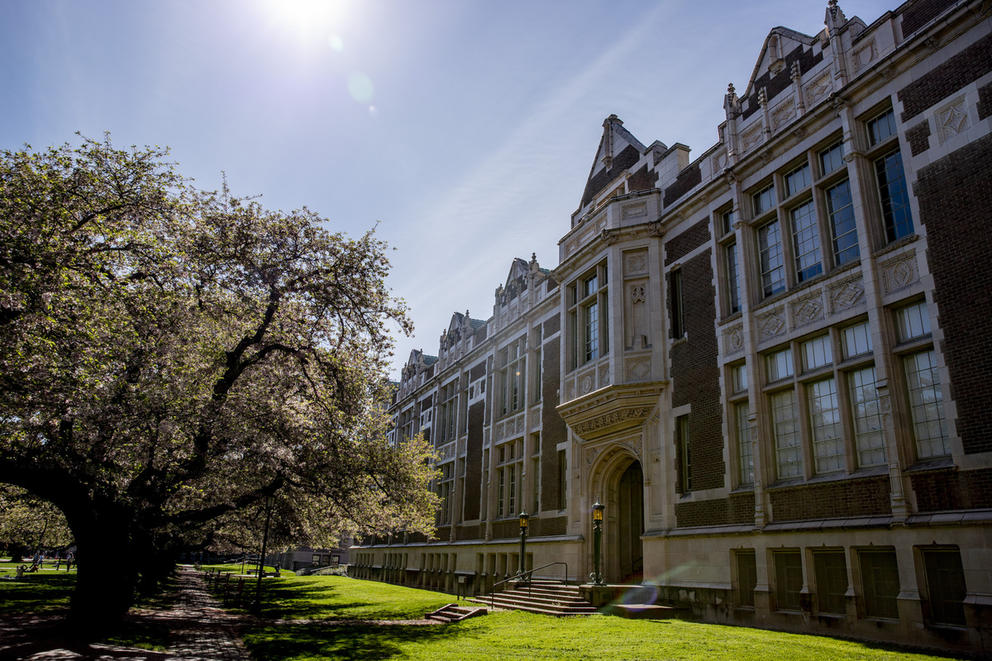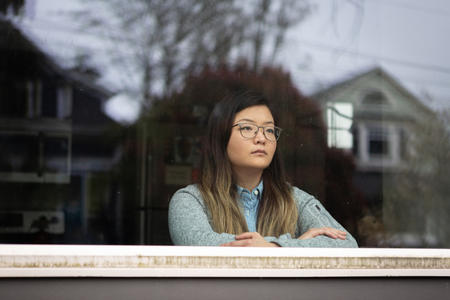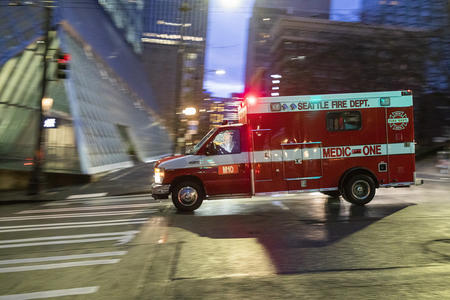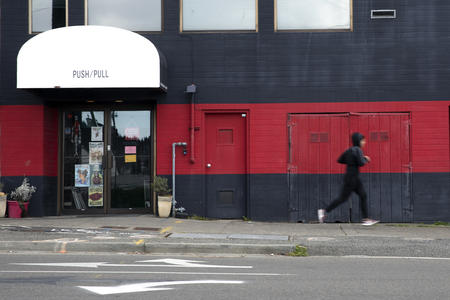Now sheltered in place and wrapping up her junior year online, Chalut finds herself frustrated. She can’t access the rolls of canvas, buckets of gesso, paintbrushes and copper plates still stacked in her studio. And without the acids, solvents and inks Cornish usually provides, let alone the school’s large printing presses, she can’t really make much art — which, in her case, is homework and classwork.
“We’re all just trying to figure out what an online school looks like,” she says. “But as amazing as my faculty is, there’s simply no way for them to get flammable acids that I need to work with into my house.”
The stymieing of her art isn’t the only thing Chalut is worried about. “I am spending thousands of dollars — and I'm going to be in debt for it for the rest of my life — to sit on my couch,” she says. “I feel like I’m not getting what I paid for.”
Chalut is not alone. Like her, hundreds of thousands of college students in the U.S. and U.K. are calling on schools to lower or pay back some of their tuition as classes have moved online.
In Washington, students from Cornish have joined others at the University of Washington, Washington State University, Western Washington University and Seattle University in launching petitions to request partial tuition reimbursement for this year’s winter and spring quarters. After suddenly seeing studios, libraries and recreation centers closed, hands-on education curtailed, capstone year-end graduation ceremonies canceled and classes moved to laptops, most of them say the same thing: Virtual college is not what they paid for.
In addition, the income streams that helped students pay for school have dried up. “Many of our students have lost their jobs during this crisis,” a change.org petition from WWU students states, “and are therefore not in a financial position to be paying full tuition fees, especially for an education that is only half the quality they originally paid for.”
Want to pitch in? Here's how to help struggling food banks in Washington state.
At UW, the state’s largest university, with over 50,000 students, petitions have garnered more than 14,000 signatures (though anyone, not just students, can sign).
Shortly after the university announced it would switch to online-only instruction for the spring quarter, Alex Davidson, a freshman in political science, sent a survey to his fellow students (as first reported by The Daily). “The largest ask” from students, Davidson says, “was the need for a tuition reduction from the university.”
Since then, he has helped form the UW COVID-19 Advocacy Coalition, and has introduced a proposal to the school’s Student Senate for a 12.9% spring quarter tuition refund.
“We all want to see the university take greater action towards alleviating the burden that the university is placing on students,” Davidson says.
That burden, he says, is both financial (by losing on-campus and other jobs) and academic. “Some students say they are learning 40% less than they normally would. That’s a disgrace,” Davidson says. “We’re not receiving that prestigious education.”
Read more about how the pandemic has also affected Seattle's popular nightlife spots.
“Instructors are going to significant lengths to provide an excellent and thorough learning experience for students, despite the current challenges,” says UW spokesperson Victor Balta, offering examples of instructors mailing kits and equipment and instructional videos to students to do science experiments at home. “These are extraordinary times and our instructors are responding accordingly.”
Online learning presents other problems, too, Davidson says. His psychology course, for example, consists of “prerecorded lectures from 2018.” A few weeks ago, he wasn’t able to access the recordings because of a technical glitch. “It would be the same concept of me going to Kane Hall wanting to attend my lecture but the professor basically locking the door,” he says.
International students find themselves in a particular conundrum. “An international student with the coalition had to move back to Taiwan,” Davidson says. “When it’s 8 a.m. here, it’s [11 p.m.] there. It places incredible academic pressure on her about attending lectures, meeting assignment deadlines or attending time-specific exams.”
And then there’s the emotional toll, says Mariela Frias, a senior at WSU, who started a petition to receive partial refunds from the university. Online learning, she points out, just doesn’t work for everyone, particularly students with attention-deficit disorders. “The university says a lot of people enjoy it,” she says, but “once you see it a week or two, you see people’s mental health deteriorate.”
Medical students feel sidelined in the fight against COVID-19. Read more about why they want to help.
Many national and local institutions, including Cornish and WSU, have made grading accommodations with pass/fail and universal pass options, and have (partially) refunded nontuition charges such as housing and meals. UW is not charging students who left their housing for the spring quarter, and is refunding some of the students’ dining account card balances.
Tuition refunds, however, are a different matter.
“I would say colleges and universities will say uniformly no to tuition refunds,” says Richard Vedder, professor emeritus of economics at Ohio University who writes about higher education issues.
While he acknowledges the quality of education may suffer from the move to online learning, Vedder says most colleges don’t have a ton of cash on hand — particularly not now, near the end of the academic year. “Financially, it would be devastating to schools,” he says. “A typical school gets minimally 30% of its income from tuition fees. Saying ‘we’ll give you that back’ would be devastating to them unless there’s some school with huge cash balances, which would be the exception rather than the rule.”
Most schools, including Cornish, UW and WSU, say they don’t currently plan tuition refunds because credits and degrees are still being earned. While, yes, things have changed, many institutions argue, operating costs have not. Many say they’ve increased.
“With the university shifting to online instruction for spring quarter, we are actually increasing our investment in instructional costs,” says the UW’s Balta. Making new and existing services available online, plus investing in new technology, costs more, Balta says. He also says the school has awarded more than $235,000 in emergency financial assistance to students through a fund fueled by a combination of institutional monies and private donations to the UW.
Like the UW, WSU won’t be offering tuition reimbursements or reductions, says university spokesperson Phil Weiler. “You’re still getting the same content, you’re still meeting the same faculty members and seeing your fellow students,” he says, adding that the university is reviewing various fees students pay “line by line” to see which ones it can refund.
But the calculations are tricky, Weiler adds, particularly because colleges will face significant budget challenges.
Tuition revenue will likely take a hit. Even if colleges can return to in-person education in the fall, it’s hard to predict who will actually show up. Who will reenroll? Will parents feel comfortable sending their freshmen to campus? Will international students, who often pay the full sticker price for tuition, come back? Schools have also lost part of their revenue from room and board and have canceled study abroad programs, athletic events and conferences. Public colleges also expect cuts in state funding. A volatile stock market means endowments bring in less money, too.
“We don’t know what the future holds,” Weiler says.
It’s likely the current economic uncertainty will put colleges in financial danger, says Sandy Baum of the Center on Education Data and Policy at the Urban Institute, a Washington, D.C.-based research organization. Particularly tenuous are smaller private and regional public colleges with an already tight budget. “A lot of them won't make it,” she says.
Central Washington University, a public university in Ellensburg, has declared a “state of financial exigency,” a crisis declaration that gives the school broad powers, including terminating faculty appointments. (The college has said it plans to maintain current staffing levels through at least June 30.)
Most at risk, Baum says, are the “nonprofit, small private colleges that are very tuition-driven and are always struggling and don’t have large endowments.”
That’s Cornish College of the Arts in a nutshell. Even before the COVID-19 pandemic, the school’s financial situation wasn’t rosy. Enrollment had been declining, which is a problem for a school that powers 93% of its operations and costs with tuition revenue.
Cornish simply doesn’t have the resources to give tuition refunds, says Cornish President Raymond Tymas-Jones (though he didn’t rule it out in the future). “The majority of our expenditure is tied up in salaries for our faculty and staff who are fully employed. We still have rent, utilities — none of that went away,” he says, adding that an emergency fund has already distributed $24,000 and laptops to students in need.
The federal CARES Act, a stimulus bill that includes roughly $14 billion for higher education (see sidebar), is dispensing $316,407 to Cornish for student emergency financial aid, but that will cover only food, rent, course materials and other expenses — not tuition, Tymas-Jones says. An additional $316,406 is allocated to the school, but Tymas-Jones says these funds are supposed to cover “costs associated with the impact of COVID-19.”
Besides, he says, the “essence and core” of degree requirements and credits are still being provided. Remote learning instructions are different, “but they are quality instructions,” he says.
Students don’t necessarily agree. It’s not a question of quality when a lot of the instructions don’t actually happen, says Chalut, the Cornish junior.
“Learning art is physical. You need a space to be able to practice. Dancers need places where they can dance,” adds Cornish theater senior MacKenzie Shapiro, who (with Chalut) created the refund petition to Cornish.
This semester, Shapiro says, she’ll miss out on making a voice reel (a portfolio for voice actors, critical to finding work) and other practical learning. Her stage combat class has been “abandoned,” she says, as no one has access to swords or a teacher who can safely wield one.
“It means that I don’t really get my education,” Shapiro says. “I get essentially a master class like you could get on the internet.”
As students wonder what their academic future holds, so do the teachers and administrators facing these unprecedented circumstances.
“There’s nothing comparable to [the current college disruptions] in American history, certainly [not] post-World War II,” says Michael P. Meotti, executive director of the Washington Student Achievement Council. Maybe the 1970s, he posits. At that time, hundreds of universities, colleges, and high schools across the country closed briefly after the Kent State University shootings and protests over the Vietnam War.
But the number of closed schools is certainly higher now. Schools were closed (or destroyed) during Hurricane Katrina, as well, Meotti points out. But in contrast, “now, you have a campus, your computer systems are running, your people are there, but you’re not moving because of the health risk,” he says. “We’re in totally uncharted waters.”







